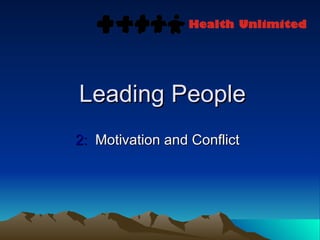
2 Leading Teams - Motivation and Conflict
- 1. Leading People 2: Motivation and Conflict
- 11. CONFLICT
- 23. Effect of Power Difference
- 24. Take a Break
- 31. Active Listening
- 42. Thankyou
Notes de l'éditeur
- This follows on from the Leadership Skills session. The second part in a series on Project Cycle and general management for NGO mid level staff in developing countries. Slide 22 is country specific
- But, a little effort with this pays off as better work from each person and from those around them.
- 3 Clicks Do you spend time after work, in the village, have a drink. In Cambodia you can have problems with external relationships – family etc
- But, a little effort with this pays off as better work from each person and from those around them.
- Remember before we looked at Herzberg’s list of demotivators and satisfiers, what I called Starters and Stoppers. Basic conditions to meet and then added factors to motivate. Which is which?
- 1. Don’t micromanage – give staff some power. 2. Tell them they are important and do a good job – but don’t make it up if unwarranted. 3. Empathise with team about negatives; acknowledge frustrations and realities of the job. It is not useful to dwell on negatives, but showing an understanding of these things can build morale and trust and improve motivation. 3 Clicks
- Everyone is equal, Right?? GROUP DISCUSSION of each person in list Young person – will need guidance to feel secure NGO worker – changed jobs: want challenge? Move up? Training, tasks, exposure to practical work, advancement TBA for 10 years – may want to widen the scope of their influence, exposure to business methods. 20 year service – may want to work out their time in peace – stability,
- 4 Clicks
- DEAL with problems
- Important to clarify the issues. Write things up.
- Go to next for discussion
- 4 clicks
- 3 Clicks. Clear the air. Meetings have to stick to the Agenda, but ‘other business’ should be available.
- Examine your systems for managing problems, including dispute resolution systems, - use quiet times to look at process improvements that can be used in times of stress.
- Competing - your own needs are put over others. It relies on an aggressive style of communication, low regard for future relationships, and the exercise of coercive power. Those using a competitive style tend to seek control over a discussion, in both substance and ground rules. They fear that loss of such control will result in solutions that fail to meet their needs. Competing tends to result in responses that increase the level of threat. Accommodating , also known as smoothing, is the opposite of competing. Persons using this style yield their needs to those of others, trying to be diplomatic. They tend to allow the needs of the group to overwhelm their own, which may not ever be stated, as preserving the relationship is seen as most important. Avoiding is a common response to the negative perception of conflict. "Perhaps if we don't bring it up, it will blow over," we say to ourselves. But, generally, all that happens is that feelings get pent up, views go unexpressed, and the conflict festers until it becomes too big to ignore. Like a cancer that may well have been cured if treated early, the conflict grows and spreads until it kills the relationship. Because needs and concerns go unexpressed, people are often confused, wondering what went wrong in a relationship. Compromising is an approach to conflict in which people gain and give in a series of tradeoffs. While satisfactory, compromise is generally not satisfying. We each remain shaped by our individual perceptions of our needs and don't necessarily understand the other side very well. We often retain a lack of trust and avoid risk-taking involved in more collaborative behaviours.
- 4 Clicks Number 5 is the most productive method Go to next slide for example
- 1 Click
- 1. Power distance example: in the first module we saw this… Air Crash Investigation – Dutch airliner taking off at Tenerife, KLM culture is high power distance in the cockpit, copilot was unable to question his boss, crashed into Pan Am jumbo taxiing on runway, lead to 583 deaths.
- As with all these areas of management, there are many theories. One is the 8 steps to conflict resolution, but we will not find these useful as they are used in the west.
- More… next slide ‘active listening’
- 4 Clicks By this stage, the conflict may be resolved: Both sides may better understand the position of the other, and a mutually satisfactory solution may be clear to all. However you may also have uncovered real differences between your positions. This is where a technique like win-win negotiation can be useful to find a solution. There are three guiding principles here: Be Calm, Be Patient, Have Respect… 4: Reason for decision: budget, time, needs of others, policy…
- 3 Clicks Focus on procedure – so this is how we will work forward… this when we will meet .. Once you start to agree on this you have started agreeing!
- 4 Clicks Focus on procedure – so this is how we will work forward… this when we will meet .. Once you start to agree on this you have started agreeing!
- 1 Click
- 1 Click